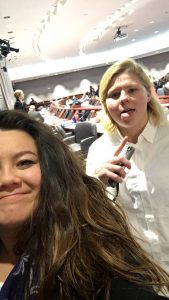“Budget cuts will undermine the mission of our school which is to provide impassioned teenagers from all races, religions, and incomes with equal and superior opportunities in the arts and our central community,” said 16 year old Margo Lutz as she addressed the board at the Appropriations Committee Public Hearing regarding the Governor’s proposed budget allotments for the 2017-2018 school year.
On February 21st 2017, at the legislative office building in Hartford Connecticut, the question as to where money is distributed after budget cuts and after receiving state education aid was brought into light. The goal of Governor Malloy is to readminister money to the districts most in need; however, criticism about how “need” is measured has become a problem for local administrations due to feelings of neglect. At this point talk about the Husky Health Program and free/reduced lunch prices made their way into the hearing discussion regarding measurements of wealth within schools.
Throughout our time spent at the hearing, we heard testimonials of students, parents, and administration all vying for aid to ensure a better future for themselves and their children. Most notable was interim superintendent Aresta Johnson.
Johnson advocated on behalf of Bridgeport Public Schools emphasizing the need for additional funding through the state education aid. According to Johnson, Bridgeport Public Schools, “16% of students are in special education classes, 15% of students are in ELA (English Language Arts courses).” While Johnson stressed the need for funding for the children within the Bridgeport Public Schools, she did also mention the inadequacies to meet pension.
It appears that there are clear inequalities throughout the public school system in Connecticut, and the allocation of state funds is a complex and arduous task due to the amount of “need.” However, what one often defines as a necessity can so often be misinterpreted and skewed by another. While some students testified about the quality of their music and arts programs, others testified about their Boys and Girls club and the need to keep similar programs for future endeavors. One student at the hearing stressed the importance of after school tutoring programs because as an ELA student her parents are incapable of helping her with her homework.
The whole point of an education is to provide an equal opportunity for children regardless of race, religion, or income level. In order to best allocate resources appropriately and to those who need them, state aid needs to refocus priorities on providing better futures for the children within the public school system. Rather than limiting funds for something that is already working like for example the Future Farmers of America Organization and the Boys and Girls Club, limit funds on organizations that require less need, like for example charter and private schools. If a family really values the unique experience that charter or private schools provide students, perhaps limiting state funds to private schools won’t affect attendance rates at all. Most families who have children enrolled in private schools, have the means to pay for them. If state funding is provided to public school systems, the quality of education would increase and provide a meaningful education for families who can’t afford a private education.
Lobby of the Legislative Office Building
Inside the Hearing

